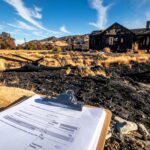Tall wood buildings, or mass timber construction, are proliferating as developers and builders embrace its environmental, aesthetic and economic advantages. Using solid wood panels to frame walls, floors and roofs, this evolving technology is taking a growing market share worldwide.
The number of mass timber projects completed, under construction or in design increased about 40% from September 2022 to June 2024, according to data from Woodworks, the Wood Products Council. The Forest Business Network has projected that the number of mass timber buildings under construction could double yearly to more than 24,000 by 2034.
This trend challenges insurers to understand the materials, techniques, advantages, and potential pitfalls of mass timber construction to assess and rate these risks more accurately. As described by the American Wood Council and International Code Council, major types of mass timber include:
- Solid sawn timber or saw lumber, used as bending members and columns
- Glued laminated timber (GLT) or Glulam, used for beams, columns and panels
- Nailed-laminated timber (NLT), generally used in floor and roof decks
- Dowel-laminated timber (DLT), a new-generation mass timber material popular in Europe
- Structural composite lumber (SCL), suitable for beams, headers, rafters and scaffold planking
- Cross-laminated timber (CLT), used for load-bearing walls, floors and roof decks
When used to form structural elements in mass timber buildings, these materials must meet fire resistance requirements, which are determined based on how much of a cool core section they retain in a fire event to support the design load for a required time period.[1]
Increasing use of mass timber in tall buildings led the International Code Council (ICC) to add three new construction types—each with its own set of FRR requirements—to the 2021 edition of the International Building Code (IBC):
- Type IV-A – Mass timber elements are fully encapsulated by approved noncombustible material (up to 18 stories or 270 feet).
- Type IV-B – Mass timber elements have limited portions of ceilings, beams, columns, or interior walls exposed (up to 12 stories or 180 feet).
- Type IV-C – Mass timber can be fully exposed without encapsulation, except for shafts, concealed spaces, and outside of exterior walls (up to 9 stories or 85 feet).
Multiple full-scale tests have been conducted to understand the performance of mass timber, including CLT with and without encapsulation, in fires. The results suggest clear advantages for protected CLT—and the critical role sprinklers can play in controlling fire spread and preventing mass timber ignition. Additional testing of second-generation CLT showed improved fire performance with the heat-resistant adhesive used to bond its layers.
Nevertheless, concerns remain regarding mass timber buildings, as noted in the journal Fire and Materials. More research is needed on how the materials perform in fires; how different designs such as large, open floor plans may affect the building’s fire performance; how sprinklers should be designed to protect them; and the potential impacts of water damage or moisture. Approaches to damage assessment and costs for repair or replacement are also unclear. And from a safety perspective, evacuation time and whether it’s safe for fire services to access require more study.
Verisk has added to and modified its Specific Commercial Property Evaluation Schedule (SCOPES) in response to this new technology and evolving building codes. A new construction class M provides guidance on fire risk rating for this unique construction type in the 2025 SCOPES Revision:
- All three mass timber construction types defined by the 2021 IBC will be categorized between “Non-combustible construction” (CC-3) and “Joisted Masonry construction” (CC-2) in SCOPES as “Mass Timber construction” (CC-M).
- Weighting factors are created to reflect the fire risk posed by Mass Timber construction. These factors are determined based on the results of an engineering analysis Verisk conducted.
Loss cost and underwriting reports have also been modified accordingly for wind risk rating. Mass timber buildings are deemed to achieve wind-resistive performance similar to Fire Resistive or Modified Fire Resistive constructions as defined in SCOPES.
With the upcoming release of the SCOPES revision, Verisk will start to collect mass timber construction data on-site. As a member of the Property Insurance Research Group (PIRG), Verisk has been sponsoring projects of the Fire Protection Research Foundation, a research affiliate of the National Fire Protection Association, since 2018. Several potential mass timber research projects have been discussed and initiated with PIRG to address insurers’ concerns with mass timber.
After the SCOPES revision release—and with more mass timber building data supporting a better understanding of mass timber fire performance—Verisk will monitor the progression of this new type of construction to help insurers enhance their rating methodologies.
Verisk encourages users to watch for the inclusion of this new construction class with the release of the SCOPES revision in 2025—and contact Customer Support with any questions.
By Xiaochuan (Lydia) Shi, PhD, CFPS, and Kevin Kuntz, PE, CFPS, MIFireE, UL-CRP – Property
[1] Technical Report No.10, “Calculating the Fire Resistance of Wood Members and Assemblies,” American Wood Council, 2016.




















 Viewpoint: Mapping Evolving Regulatory Terrain for MGAs, MGUs and Other DUAEs
Viewpoint: Mapping Evolving Regulatory Terrain for MGAs, MGUs and Other DUAEs  Aon Adds to List of Brokers Suing Howden US for Alleged Poaching, Theft
Aon Adds to List of Brokers Suing Howden US for Alleged Poaching, Theft  Unpacking a Consumer Intervenor’s Novel Idea
Unpacking a Consumer Intervenor’s Novel Idea  Berkshire Hathaway Announces Leadership Appointments: New CEO at GEICO
Berkshire Hathaway Announces Leadership Appointments: New CEO at GEICO 




